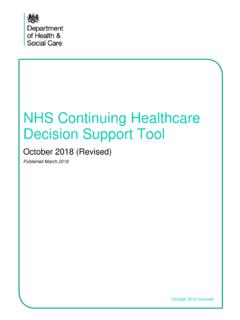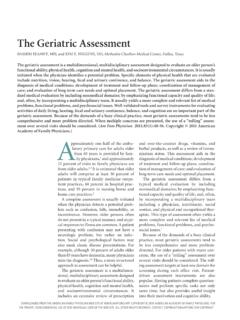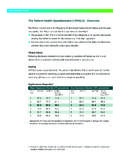Transcription of DISABILITY-COMPETENT CARE SELF-ASSESSMENT TOOL
1 DISABILITY-COMPETENT CARE SELF-ASSESSMENT tool Last modified 05/22/2013 1 Please submit feedback to INTRODUCTION Last modified 05/22/2013 2 Please submit feedback to Purpose The DISABILITY-COMPETENT Care SELF-ASSESSMENT tool was developed to help health plans and health systems evaluate their current ability to meet the needs of adults with functional limitations and to identify strategic opportunities for improvement. Serving Persons with Functional Limitations This tool focuses primarily on persons with functional limitations, however, DISABILITY-COMPETENT care is appropriate to all individuals with disabilities because its intent is to remove barriers to timely and appropriate health care.
2 People with disabilities are a diverse group, including children, adults of all ages, people with vision or hearing loss, as well as people with physical, mental health, developmental, or intellectual disabilities. They may have limitations in learning, understanding, remembering, reading, speech, or mobility. Rather than focusing on a diagnosis such as spinal cord injury, multiple sclerosis, or mental illness DISABILITY-COMPETENT care focuses on providing care and supports for maximum function and addressing the barriers to integrated, accessible care.
3 Meeting the needs of this population requires special attention to an individual s expectations of independence and autonomy, as well as his or her participation in work, school, and community or social activities. Current models of care delivery are not always well suited to addressing the needs of those with functional limitations. Care is typically provided in clinical offices or inpatient settings, which may have physical barriers ( , inaccessible routes from parking areas and drop-off points) or inaccessible equipment ( , exam tables and scales). Common clinical practices may also impose procedural barriers, including insufficient time allotted for visits (people with functional limitations may need longer appointments to accommodate for the time required for safe transfer and positioning techniques) and lack of flexibility to accommodate the individual when issues such as caregiver availability or transportation requirements cause unpreventable delays.
4 Individuals with disabilities may face both barriers of inconvenience and barriers that prevent optimal care delivery when trying to access the standard of care that individuals without disabilities may take for granted. Rather than focusing on a diagnosis, DISABILITY-COMPETENT care focuses on providing care and supports for maximum function and addressing the barriers to integrated, accessible care. Last modified 05/22/2013 3 Please submit feedback to How can we best serve people with disabilities? The Aspirational Model: DISABILITY-COMPETENT Care DISABILITY-COMPETENT care is participant-centered, provided by an interdisciplinary team (IDT), and focused on achieving and supporting maximum function.
5 It is intended to maintain health, wellness, and life in the community as the participant chooses. DISABILITY-COMPETENT care recognizes and treats each individual as a whole person, not a diagnosis or condition. The model, therefore, is structured to respond to the participant s physical and clinical needs while considering his or her emotional, social, intellectual, and spiritual needs. The aspirational model of DISABILITY-COMPETENT care depends on health care professionals sharing collective responsibility for the execution of the care plan as well as the health and well-being of the participant.
6 This requires health care professionals to collaborate across disciplines and care settings and engage in a meaningful partnership with the participant. To achieve this aim, health care professionals may need to develop new capabilities in teamwork, interdisciplinary collaboration, and participant-directed care. The aspirational model of DISABILITY-COMPETENT care described in the tool is derived from the lived experiences of persons with disabilities and over 20 years of experience from the following three programs: Community Medical Group/Commonwealth Care Alliance in Massachusetts Community Health Partnership in Wisconsin Independence Care System in New York These programs are unique in their integration of Medicare and Medicaid services and funding, encompassing the full range of acute care, primary care, and long-term services and supports.
7 Each organization has evolved in the context of local care practices and resources. Each has also achieved documented success in improving the experience of care, promoting the health of the population served, and reallocating resources to increase care management and primary care support by capturing avoidable episodes of care. Three Domains of Success in the Aspirational Model Relational-based Care Management Participant-centered care is based on the recognition that the participant is not merely a passive recipient of medical care, but rather the primary source for defining care goals and needs.
8 This type of care requires cultivating a relationship with the participant, seeing him or her as a whole person with hopes and preferences, and recognizing that the participant is oftentimes the best steward of resources. Inherent in participant-centered planning of care goals and needs is also the concept of the dignity of risk,1 which honors and respects the participant s choices even if they are inconsistent with the recommendation of the IDT. 1 Dignity of risk means the right of individuals to choose to take some risk in engaging in life experiences, even if that choice is not one recommended by a health professional ( , choosing to smoke).
9 Last modified 05/22/2013 4 Please submit feedback to Highly Responsive Primary Care A highly responsive primary care network is critical for timely, ongoing, and accessible care. The provision of primary care is a vital component of DISABILITY-COMPETENT care, which involves timely access to care in a variety of settings (in a clinical office practice, community, or participant s home) as well as the capacity to assess and address newly emerging symptoms of concern, and the allocation of care and services. Comprehensive Long-term Services and Supports Long-term services and supports (LTSS) comprise the range of home- and community-based care services and supports that enable a participant to reside in his or her home and participate in the community.
10 Comprehensive LTSS often involves the identification of functional needs and the prioritization and allocation of resources. This commonly requires investing in resources and equipment to support the health and well-being of the participant, which, in turn, may prevent avoidable episodes of illness or progression of illness. There are a wide range of populations that would benefit from this aspirational model of DISABILITY-COMPETENT care. How the model is applied will vary based on the population s characteristics, care needs, and care utilization patterns.















